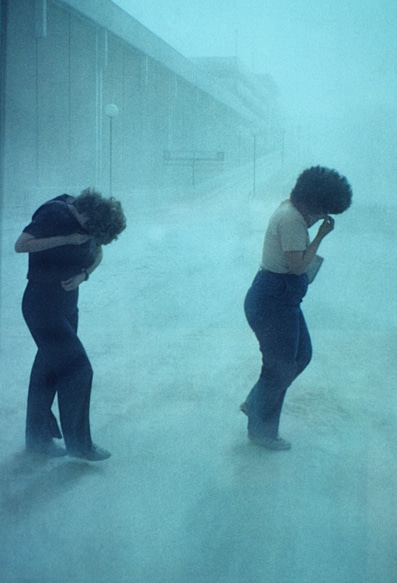See that ash plume heading east? That’s what covered us on the WAZZU campus 35 years ago today following the eruption of Mt. St. Helens in Washington State. We were shrouded in a billowing cloud of ash so dense that it choked out the sun turning noon into midnight. This is my story of experiencing that environmentally cataclysmic event and those hot, pyroclastic days that followed, stranding a coughing a wheezing PAC 12 community one week before finals.
Sunday, May 18, 10:30 am: Just returning from a fraternity cruise on the Snake River, I was touring two soon-to-be freshman coeds around the campus when we noticed dozens of students coming to their dorm balconies and looking toward the southwest sky. Rolling our way was the most menacing grayish-black cloud that I have ever seen. (It made a Phoenix dust storm look like a leaking vacuum bag.)
 Noon-ish: The ash cloud consumed the scenic Palouse region and our campus. It was the closest thing to a nuclear winter that I could imagine: Complete darkness overhead with a 360-degree ring of eery, bright orange light on the horizon. For the first time in my life, the emergency broadcast system squawked to life imploring us to “Seek refuge indoors”. Cops barked instructions from the loudspeakers on their patrol cars as they cruised the campus through the volcanic particulates that floated down like a gray snowfall; their flashing lights muted by the ashen veil.
Noon-ish: The ash cloud consumed the scenic Palouse region and our campus. It was the closest thing to a nuclear winter that I could imagine: Complete darkness overhead with a 360-degree ring of eery, bright orange light on the horizon. For the first time in my life, the emergency broadcast system squawked to life imploring us to “Seek refuge indoors”. Cops barked instructions from the loudspeakers on their patrol cars as they cruised the campus through the volcanic particulates that floated down like a gray snowfall; their flashing lights muted by the ashen veil.
5 pm: Word came in that the campus would be closed for the foreseeable future until authorities could assess the potential harm of the ash that now blanketed the region with as much as three inches of what used to be Mt. St. Helens. We immediately took an accounting of our beer supply and began our first in a marathon of Risk games.
 Monday, May 19: We awoke to a hot sun streaming through a brownish-gray atmosphere, similar, I’d guess, to the Olympic Village in Beijing. Dust masks were handed out by campus personnel, and again we were all asked to remain indoors. The fine dust started to creep in everywhere, and the TV news showed cars and trucks stranded along the side of the road as the ash literally choked carburetors to death. There was no transportation into our out of Pullman. We were completely cut off from the outside world.
Monday, May 19: We awoke to a hot sun streaming through a brownish-gray atmosphere, similar, I’d guess, to the Olympic Village in Beijing. Dust masks were handed out by campus personnel, and again we were all asked to remain indoors. The fine dust started to creep in everywhere, and the TV news showed cars and trucks stranded along the side of the road as the ash literally choked carburetors to death. There was no transportation into our out of Pullman. We were completely cut off from the outside world.
Tuesday, May 20: The day heated up to between 80 and 90 degrees and the campus felt like a hot, dried out dust bowl. Cribbage and Backgammon were added to the endless rounds of Risk, and crushed beer cans started to accumulate like an alley behind an Irish pub following St. Patty’s Day. Students began to venture out into the streets and down to the grocery store to replenish their supply of hops & barley. The school remained closed.
Wednesday, May 21: While the rest of the world marveled at the eruption and its aftermath, right down to tracking ash particulates as they circumvented the globe in the stratosphere, we were growing bored and restless. Rumors started to surface that perhaps finals would be completely canceled.
Then the UNTHINKABLE happened…
Thursday, May 22: In hindsight, I’m sure our innate survival instincts were trying to warn us of the looming catastrophe. I’m guessing that our senses were deadened by the constant inhalation of microscope parts of Mt. St. Helens (Was that a hemlock, squirrel, deer, or fish that just entered my lungs? Heck, it may have been Harry Truman ). We didn’t see it coming, nor were we prepared to deal with the unthinkable:
The town of Pullman ran out of beer.

The ash-filled time capsule of Mt. St. Helens in celebration of surviving the eruption as a freshman at Washington State University
Friday, May 23: Now living in what seemed to be a dry county, at least until the dust cleared, I took to Bohler gym to play a round of basketball to ease my nerves. Not five minutes into the game, I’m chasing down a long, overthrown pass, and run headlong into the wall under the basket. In an attempt to brace for impact, I throw up my hands catching my middle finger and neatly breaking it so it overlapped my pinky at a 45-degree angle. In one final gasp, St. Helens was giving me the finger, and using my own appendage for added insult.
Saturday, May 24: The Pullman airport reopens, while campus officials prepare to open classes again on Monday for finals. However, they say that if you are too traumatized by the preceding week’s events, that you are free to pass on finals and take the grade you currently have. I quickly raised my hand, with a throbbing, immobilized middle finger, and volunteer to be one of the first to be airlifted out of the blast zone (Well, fallout zone, anyway).
Sunday, May 25: I arrive, via Crashcade Airlines, at SeaTac International Airport as a Mt. St. Helens refugee; my mother and father anxiously waiting for me at the gate. Following a round of hugs, they looked at me and asked the only question the desperately relieved parents of seven could ask of one of their later children, “Are your grades REALLY good enough to miss finals?” I flipped them my finger reminding them that the emergency room nurse practitioner at Pullman Memorial guessed that it probably needed immediate attention by a hand surgeon. I truly had no choice, and appreciated their misdirected concern.
Yes, 30 years later, I often look back on the day St. Helens blew, and I know now that Survivor Man has nothing over me.
Where were you went St. Helens erupted?












at 11:06 pm
Heaps of Great information in your posting, I favorited your blog so I can visit again in the future, Thanks
at 1:15 pm
[…] improbable story of survival during the 1980 the eruption of Mt. St. […]
at 9:09 am
Park, thanks for the trip down memory lane, or the hazy recollection of memory lane is more likely. My story after the mtn blew is a little different, racing the cloud of ash along the gorge, losing the race at the tri-cities, a day in the gymnasium at washtucna, then the games in Pullman began….
tim
at 9:13 am
All good times, Tim.